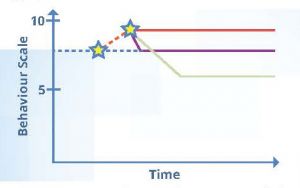New things can be a bit scary. As a prudent example, we recently replaced the dishwasher in our home. It’s been months now and I still haven’t turned it on. I can stack it and empty it, but the buttons on the front of it confront me, convince me I’m about to make a mistake. I pine for the old dishwasher that had one dial. Sure, it didn’t actually clean the dishes any more … but at least I understood it. And right now, many of you (just like my wife) are smacking your foreheads in disbelief at my antiquated and unproductive approach.
And as it is with Teacher Practice. For decades, we’ve given punitive and out-dated practices a consistent, clear and justified run despite the mounting evidence that it just isn’t working. We might ‘try’ something new, but the moment that it becomes difficult we’re tempted to assume a default adversarial position and usual role, previous patterns of negative student behaviour now likely reinforced.
It’s time we backed ourselves a little more. That we understood the way that behaviours change – gradually and individually. That we acknowledge our intellect, creativity and knowledge of our students. That we make a smart change – and we stick to it, even with our most difficult students.
You can be forgiven
The reason we sometimes struggle to sustain practice change is that it often invokes a spike in the undesirable behaviour. Consider the graph below for a moment:
Imagine one of your most challenging students as tracking along the blue dotted line at around 8/10 management difficulty. At the first star, exasperated, you try something different – something you thought deeply about, perhaps shared with a colleague and came to a conclusion that it was solid practice. The high likelihood is that the student will resist this change (for instance, ignoring calling out – you know what’s coming!) and you’ll see an increase in the problem behaviour, with the student travelling the red dotted line.
At the second star, we make a fundamental decision. You will be tempted to scream “I tried that and it didn’t work!”. If you give up at this point, referring to default measures, then only two things can happen. If you are fortunate, the student will quickly travel the purple line and re-establish their desired classroom norm. If you’re not so lucky, you just established a brand new norm – the red line. Ouch. That’s a lot of pain and effort for a negative result.
However, if you persist with your well considered approach that matches your personal and school values, then the rewards will come. Over time, the target behaviour diminishes (follow the green line), crosses the point of the old norm and plateaus as a new, improved norm. You’ll notice that the new horizontal version of the green line is not a miracle. There are still behaviours to address, but you can now apply this successful method to old and emerging target behaviours for sustained improvement and relief.
You’re already good at this. Teachers are remarkable at creative intervention design – we just need to be strong and forthright enough to see through the application. And this isn’t just about your students, but about you. Focus in this area will increase your effectiveness and decrease your stress. As a particular cosmetic company would tell you … it’s because you’re worth it.
THE CHEAT SHEET
Don’t have time to absorb the whole article today? Here’s the big points …
1) Stick with good practice until it works.
2) We’ve run with punitive measures for a long time.
3) It’s going to get worse before it gets better.
4) Don’t give up before things improve.
5) You’re already good at creative interventions.
AITSL STANDARDS FOR TEACHERS… and you addressed them by reading!
The Big One
4.3 Manage challenging behaviour.
But also …
1.5 Differentiate teaching to meet the specific learning needs of students across the full range of abilities
3.3 Use teaching strategies
3.5 Use effective classroom communication
7.1 Meet professional ethics and responsibilities
